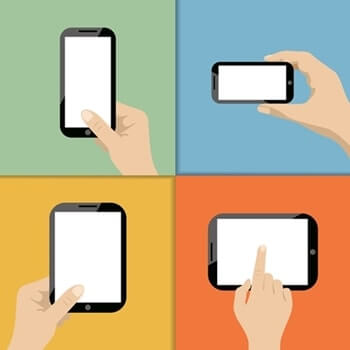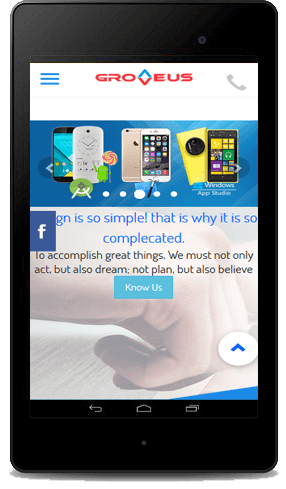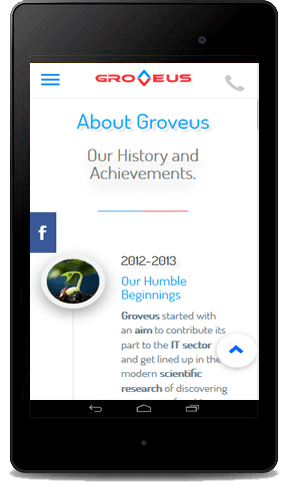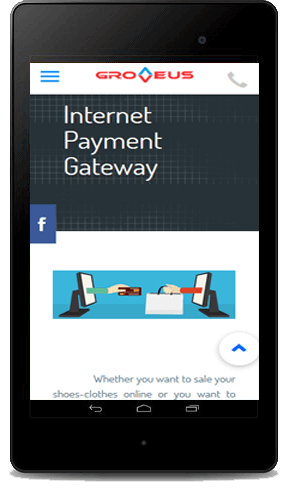Mobile Website or Responsive Website in Keshod
Designing And Developing in Keshod
Almost 80% users are visiting your website on their multiple devices like Tablet, Mobile phones with Android, iPhone or Windows 10 Smartphones or even on the TV.
Almost half of your website's traffic comes from mobile devices. More and more local searchers are viewing your website on mobile. So if your website is not ready for mobile, that's a hefty chunk of your visitors, who are receiving a sub-optimal experience.
So are you really offering them a consistently exceptional experience on all the devices?
Well! It's the time to go for not only just a mobile ready website, but a multi device responsive website.
The big question is do we really need to develop a separate website for mobile or multiple devices?

There has been a confusion about the mobile website. Some key questions about this fact are:
- Is there a mobile Website?
- Is the mobile is so different that you need a completely different website for it?
- Is there only website and data, that we access using different devices?
Lots of people thinks that we need to make a separate mobile website for mobile viewing only.
Well! We don't think so.
The scenario about Mobile Web in today's era
Over the past few years, mobile web usage has considerably increased.
And no one can ignore this fact. After the Android (Android 5.0
Lollipop), iPhone and Windows mobile released to the market, the
mobile users increased dramatically. Android has changed the way of
using smart phones. Now with Android or iPhone we can do most of the
computer works on a mobile phone. In wealthy countries this change
occurred so fast due to faster mobile broadband connections and
cheaper data services. A large increase has also been seen in
developing countries where people skipped over buying PCs and gone
straight to mobile or tablet devices.
In some countries, there
are more mobile subscriptions than the total number of citizens.
Millions of people uses their smartphones to search for numerous
websites daily. It could well be YOUR website! So is it ready to be
accessed on the mobile platform.
Most visitors abandon a mobile website, if it takes more than 5 seconds to load or does not have a mobile-friendly design! This is especially true when they pay by how much data they consume. When they access your website via their mobile devices, they expect it to load quickly and your contact details to be handy. So if you still make your users view your desktop website on their mobiles, then it can get real irritating for them.
Mobile Web Design and Development Strategy at Groveus

At Groveus, user-experience is the fundamental aspect of our mobile
website development strategy. We carefully research the behavior and
intent of your potential audience to identify what specific
information they seek on your mobile website. We, accordingly, plan
your custom mobile website design to suit their needs. We custom
build the responsive version of your website in such a way that your
users can easily find and browse it across devices. Strictly adhering
to the mobile coding standards, we design a very task-oriented and
adaptive layout by simplifying the navigation and logically
organizing the call actions and links. This way we ensure an optimal
viewing experience for your readers, without having to dumb your
desktop website down for mobile.
With standards still emerging,
we hold the competence and confidence to optimize mobile websites of
multifarious intricacies. We offer a full array of mobile solutions
such as mobile website designing, mobile apps development as well as
mobile optimization and promotions.
The web has gone mobile already, have you? Travel the distance with Groveus!
CSS3 To Create A Mobile Version Of Your Website

CSS3 continues to both excite and frustrate web designers and developers. We are excited about the possibilities that CSS3 brings, and the problems it will solve, but also frustrated by the lack of support in Internet Explorer 8. This article will demonstrate a technique that uses part of CSS3 that is also unsupported by Internet Explorer 8. However, it doesn't matter as one of the most useful places for this module is somewhere that does have a lot of support - small devices such as the iPhone, and Android devices. With a few CSS rules, we can create an iPhone version of a website using CSS3 that will work all the time.
A User-Centered Approach To Web Design For Mobile Devices

For the past few years, we've heard pundits declaring each year as "year of the mobile Web"; each year trying to sound more convincing than the previous. But what is indisputable is the fact that the mobile usage of the Web is growing and evolving. As it evolves, so does the mobile user experience, driven by advances in mobile device technology - from better browsers on basic mobile phones to the increased adoption of smartphones and tablets. The term "Mobile Web" is commonly used to describe accessing the internet using a mobile device. This definition is broad enough to cover everything from using a browser on a feature phone, to using highly customized apps on smartphones or tablets.
Guidelines For Designing High Performance Mobile User Experiences

A positive first impression is very essential to relationships. People always look for trust and integrity, and they expect subsequent encounters to reflect and reinforce their first impression. The same principles apply to brands and their products. Design plays an important role in building lasting relationships with end users and, thus, in supporting the brand's promise. Users always expect mobile services to be relevant and user-friendly and to perform well enough. The limitations of the medium, however, impose significant challenges to designing products that meet all of those expectations. While often underestimated, performance is a crucial contributor to a trustworthy mobile user experience. Therefore, it should be considered a key driver in the design process. The design decisions related to performance while accounting for the needs of end users and businesses. These guidelines are based on the experiences of our teams in designing native mobile apps for a broad product portfolio and on multiple mobile platforms.
Not Your Old Java Mobile Phone: UX Design Guidelines For Smartphones

The day has changed. Technology is changing the way of everything on every moment. In your pocket right now is the most powerful "remote control" that has ever existed. It is no ordinary remote control. It can harness everything that all of the previous mass media (television, radio, Internet, etc.) can do. People aren't using them just for simple entertainment or for phone calls. They have become the hub of our personal lives. Smartphones are what younger generations know as just phones. The iPad (aka the tablet) is giving your grandma's PC a run for its money. You certainly are holding some amazing futuristic technology in your hands. It will be even better tomorrow, though, so why does it matter to us or to users? Moore's Law tells us, in effect, that these things will continue to become capable of more than anything our minds can think up.
Responsive Menus: Enhancing Navigation On Mobile Websites

Most of us are pretty familiar with responsive Web design by now. Basically, it uses a combination of a fluid layout and media queries to alter the design and layout of a website to fit different screen sizes. There are other considerations, too. For example, a lot of work has been done on responsive images, ensuring not only that images fit in a small-screen layout, but that the files downloaded to mobile devices are smaller, too. But mobile design isn't just about layout and speed: it's also about user experience. At Groveus we focus on one aspect of the user experience - navigation menus - and detail of the approaches to making them work better on mobile devices.
Finger-Friendly Design: Ideal Mobile Touchscreen Target Sizes

In darts, hitting the bulls-eye is harder to do than hitting any other part of the dartboard. This is because the bull's eye is the smallest target. This same principle can also apply to touch targets on mobile devices. Smaller touch targets are harder for users to hit than larger ones. When you're designing mobile interfaces, it's best to make your targets big so that they're easy for users to tap. But exactly how big should you make them to give the best ease of use to the majority of your users? Many mobile developers have wondered this, and most have turned to the user interface guidelines provided by the platform developer for the answer. Until recently, creating mobile web designs that look and feel like native apps has pretty much been an impossible dream. There are plenty of creative work around to try and bring that native 'feel' to mobile web browsing, but so far we've struggled to bridge the gap between native and the web. However, a slew of new, high-powered smartphones is allowing designers to finally unleash complex, preferment, native-feeling smartphone UI patterns - designed and built for the web. These patterns are blurring the lines between native apps and the web. So if you've not considered having a responsive website, you are most likely to go out of business soon.









